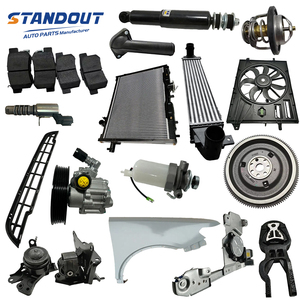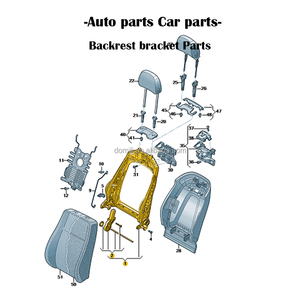(151482 products available)



























































































 Ready to Ship
Ready to Ship
























































































1. Engine: The car engine is a strong mechanical part of the car. It converts fuel into a form of energy that powers the car. There are many types of engines, including internal combustion engines, external combustion engines, and steam engines. The internal combustion engine is the most common type of all car engines. It uses gasoline or diesel as fuel and has four or six cylinders that create power. The external combustion engine is less common. It uses steam to create power, and the engine has pistons moved by the steam.
2. Transmission: The transmission is an important part of a car. It helps control the power from the engine to the wheels of the car. There are two main types of transmissions: automatic and manual. The automatic transmission is the most common type. It requires no extra effort from the driver to change gears. The manual transmission is less common. The driver must use the clutch pedal and gear stick to change gears manually.
3. Wheels and Tires: All cars have wheels and tires. The wheels are round metal parts that help the car move. The tires are rubber coverings on the wheels that grip the road. There are different types of wheels and tires for various weather conditions and driving styles. Alloy wheels are stronger and lighter than steel wheels. The driver gets better handling and braking from alloy wheels. The tire comes in summer, winter, and all-season types. Summer tires grip the road well in dry and wet conditions. Winter tires have a special tread pattern that works best on snow and ice. All-season tires are good for most weather conditions.
4. Electrical system: The electrical system in a car has many important parts that work together to create power and control the car. The battery, alternator, and starter are important parts of the electrical system that help start the car. The battery stores power and sends it to the engine to start the car. After starting, the alternator recharges the battery and powers other parts of the car. The electrical system also helps control the car. The fuse box protects the electrical parts from too much power, while the wiring harness connects and sends power to all parts of the car. Other important parts of the electrical system control the car, such as switches, relays, and sensors.
5. Chassis: The chassis is the car's body without the outer parts, such as the engine, wheels, and electrical system. It is a strong frame that holds all the important parts of the car together. There are two main types of chassis: the body-on-frame and the chassis. The body-on-frame chassis has the car body built on a strong frame. The frame holds the car body, and all the important parts of the car are fixed to the frame. Most trucks use this type of chassis. The unibody chassis has the car body built on a strong frame. The body is the frame, and all the important parts of the car are fixed to the body. Most modern cars use this type of chassis. The chassis is a very important part of the car because it holds everything together and makes driving possible.
When sourcing car parts, buyers should understand that specifications and maintenance are of utmost importance to manufacturers and end users. Here are the specifications and maintenance of various car parts:
Car Engine
It is important to check the engine oil level and top it up when necessary. The oil should be changed according to the recommended schedule. The air filter needs inspection and replacement if worn out to ensure smooth airflow. Spark plugs should be checked and replaced when needed for efficient combustion. It is also important to keep the cooling system flushed and filled to prevent overheating. Belts and hoses should be examined for cracks or wear and replaced when due. The exhaust system should be checked for leaks or damage. Tire pressure and condition should be monitored for even wear. Vehicle mileage should be tracked and serviced according to schedule. Driving habits should be adjusted to avoid strain on engine parts.
Suspension and Steering
Suspension and steering systems require less maintenance. However, it is important to keep the steering column lubricated and the steering box adjusted. Shocks and struts should be replaced when worn. Wheel alignment should be checked periodically and adjusted if necessary. Ball joints and tie rods should be examined for play or damage and replaced when due. It is also important to inspect the tires for uneven wear and adjust driving habits.
Brakes
Brake parts require regular maintenance. The brake pads and shoes should be inspected for even thickness. They should be replaced if worn out. Brake rotors and drums should be examined for scoring or warping and resurfaced or replaced when necessary. The brake lines should be checked for leaks. Brake fluid levels should be maintained and flushed according to the schedule. Brake calipers should be lubricated and pistons checked for smooth operation.
Tires
Tires are the most visible car parts and require visible maintenance. They should be inspected for cracks, punctures, or damage. The tire pressure should be checked and adjusted before long trips. The tires should be rotated every 5,000 to 7,500 miles for even wear. The tread depth should be monitored to ensure adequate traction. Wheel alignment and balance should be checked for a smooth ride. Proper tire storage is important when not in use.
Electrical system
Electrical systems are hard to tell as they are not visible. However, they require regular maintenance. Battery terminals should be cleaned and connections tightened. The battery should be tested for adequate cranking power. Cables and wires should be checked for corrosion or damage. The charging system components should be examined for proper operation. Fuses should be checked and replaced if blown. The starting system should be inspected for smooth engine cranking.
Body and Interior
Exterior and interior car parts and accessories require minimal maintenance. However, it is important to wash and wax the car regularly to protect the paint. Door and window seals should be checked for wear and replaced. Interior fabrics should be cleaned and protected. Car lights should be cleaned and inspected. Exterior accessories should be checked for proper function.
Climate Control
Climate control is important in all cars. However, it is important to inspect and replace cabin air filters and keep the cooling system flushed and filled. The heater core and hoses should be checked for leaks and proper heating. The AC compressor and condenser should be examined for cooling. It is also important to adjust driving habits to maintain temperature and the expansion tank and cap inspected for leaks and pressure.
Choosing car parts can be a challenging endeavor, as a lot of factors need to be considered. Here are some of them:
Quality
When selecting a car part, it is important to consider the quality. The car part should be of great quality. This is because great quality car parts last longer and offer superior performance. On the other hand, low-quality car parts have a short lifespan and offer poor performance.
Compatibility
Compatibility is also an important factor to consider when selecting all car parts. The car part to be selected should be compatible with the car model and with other existing parts in the car. This is important because it ensures optimal performance and prevents wear and tear.
Warranty
Warranty is an important factor to consider when selecting all car parts. All car parts should come with a warranty. This is because the warranty protects the buyer in case of damage or defect. The warranty also serves as an assurance that the car part is of good quality.
Price
Price is an important factor to consider when selecting all car parts. Even though it should not be the most important factor, it is important to select car parts that can fit into the budget. Car parts should be selected that offer great value for the money.
Most car parts have different levels of complexity when it comes to replacement. For instance, replacing a battery terminal is very easy compared to replacing a timing belt.
Here are some general guidelines for replacing car parts:
Q1: Do all cars have the same parts?
A1: No, not all cars have the same parts. While many car parts are common across different vehicles, such as engines, tires, and brakes, there can be variations depending on the make, model, and year of the car. For example, an electric car will have batteries and an electric motor that may not be present in a petrol or diesel-powered car.
Q2: How can someone know which parts are suitable for a specific car?
A2: To ensure that a car has the right parts for a specific car, users can refer to the owner's manual, which provides information about compatible parts. Additionally, they can consult with authorized dealers or service centers use genuine parts that are made for a particular car model.
Q3: Are aftermarket parts as good as original parts?
A3: Aftermarket parts can be good. Nevertheless, they may not be of high quality compared to original parts. It is crucial to do thorough research and source from reputable suppliers to ensure quality and compatibility. Some aftermarket parts are made to be like the original ones and can serve effectively.
Q4: How can someone know which parts are suitable for a specific car?
A4: To ensure that a car has the right parts for a specific car, users can refer to the owner's manual, which provides information about compatible parts. Additionally, they can consult with authorized dealers or service centers use genuine parts that are made for a particular car model.